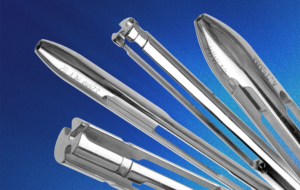Multi-Axis Milling
 TE Connectivity, offers both vertical and horizontal milling solutions, with 3-, 4- and 5-axis capability. Most milling applications begin with solid stock material, from which features are added such as holes, corners, radii, grooves, contours and profiles. The individual features can be held to very tight tolerances, as well as the relationships of features to each other.
TE Connectivity, offers both vertical and horizontal milling solutions, with 3-, 4- and 5-axis capability. Most milling applications begin with solid stock material, from which features are added such as holes, corners, radii, grooves, contours and profiles. The individual features can be held to very tight tolerances, as well as the relationships of features to each other.
Vertical Milling
The vertical mill utilizes a spindle orientated vertically to the surface that is being machined. The spindle holds cutting tools that rotate at 6,000 to 30,000 rpm depending on the machine’s capability. The workpiece being machined is normally held in vise jaws or custom fixtures designed for a specific part.
The basic vertical mill is configured to machine in 3 axes (X & Y axis perpendicular to the spindle and the Z axis in line with the spindle axis). Vertical mills with a 4th axis capability have an additional axis that rotates perpendicular to the spindle axis, usually in line with the X-axis. Machines with a 5th axis capability have an additional axis that rotates perpendicular to the 4th axis.
The multi-axis capability allows features to be machined at any angle within the part and also provides capability for machining complex contours into part surface. In many cases, this multi-axis capability allows complex parts to be machined in one operation–significantly reducing the variation between critical machined features, reducing lead-time and minimizing costs.
